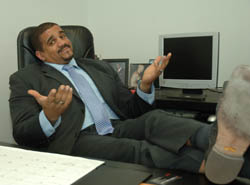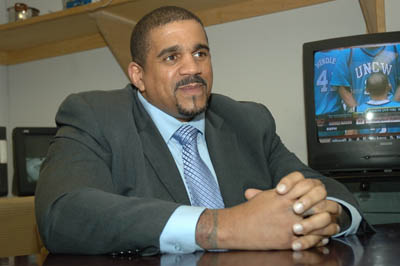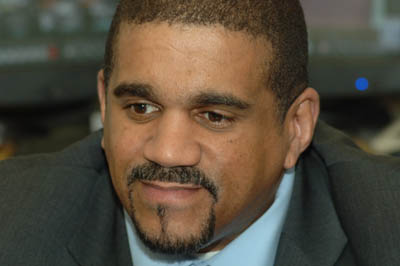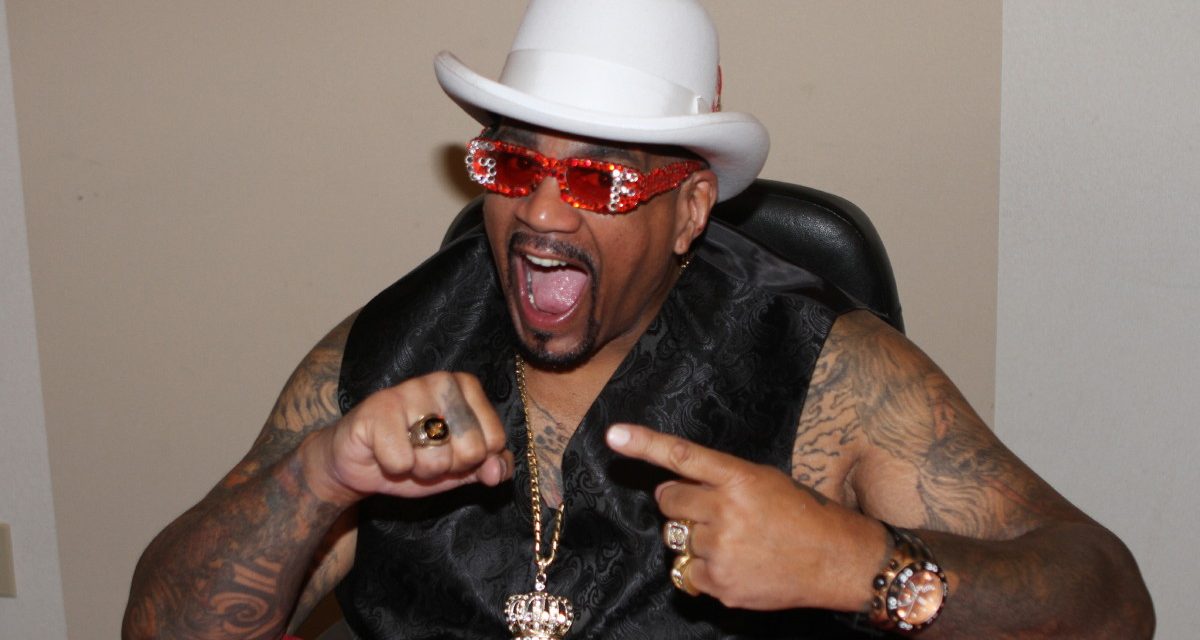One might not recognize Charles Wright at first glance. Strange, considering that during the course of his WWE career, he portrayed some of wrestling’s most colourful and memorable characters: Papa Shango and the Godfather. It must be the suit.
“You like?” he asked, spreading his large arms out to showcase the wardrobe, laughing heartily. As the general manager of Cheetah’s, one of the most famous strip clubs in Las Vegas and possibly the entire United States, the suit is the standard wardrobe. A far cry from the wild outfits he wore in the ring. But one that he’s completely comfortable in.

Charles Wright in his Las Vegas office. Photos by Mike Mastrandrea
“I’ve always worked in these places,” he told SLAM! Wrestling the day before the No Way Out pay-per-view in town, “usually as the manager. So this isn’t anything really new for me.” In fact, it was while working in a club in Vegas that Wright got discovered.
“They were filming a movie here called Over the Top — a Stallone movie. I was working in a club called The Crazy Horse down the street from where they were filming, and there were some wrestlers who would come in. One night, one of them — I think it was Jeep Swenson, but I’m not sure — said I should probably get into wrestling. I was pretty big, I was probably bench-pressing about 500 at the time, and I was all tattooed up. He had a friend named Bam Bam Bigelow who was a tattoo guy and that he’d done pretty well, and he had gone to a school called Larry Sharpe’s Monster Factory (so I should consider the same). I was looking for a change, so went out to New Jersey.”
The move was a complete departure for Wright, who had never had such aspirations before — in fact, he wasn’t even a wrestling fan, as he had spent most of his years to that point in other sports.
“(In high school) my thing was basketball. I graduated high school at about six-five, 180 pounds. Two, three years later, I was six-five, 300 pounds. I was a basketball player who weighed 300 pounds who had some speed, I was pretty quick. I could dunk a basketball any way you wanted.
“Even though I never played football in school, I got a scholarship to play football at the University of Nevada Reno. How they tested me was that they gave me a basketball and put me on a football field, and let me do what I could do; they gave me a full ride. I played offensive tackle. In my first year, I blew out my knee really bad, and it went downhill from there.”

Unable to play football, Wright didn’t finish college (“I was a hardhead back then. I was young, strong, and dumb.”), and instead took on bartending jobs, like the one at the Crazy Horse where his journey into wrestling began. It began with breakneck speed, as he was signed by Jerry Lawler after only about a month in the school.
“In my first match,” he recalled, “I beat Jerry for the CWA, or whatever it was called back then, the Mid-South title.” In addition to finding in-ring success, it was in Lawler’s USWA that Wright met a man who would go on to become one of his best friends: The Undertaker.
“They tagged us up; we were called Death Express. He was, I think the Punisher, and I was the Soultaker. We had one week,” he chuckled. “We beat everybody up so bad that Jerry Lawler took us apart after only one week.”
After his stint in USWA, Wright hit the road, wrestling in Japan for a spell, in Germany for Otto Wanz, and then returning to the States. By then, the Undertaker had signed with WWE (then WWF) and he recommended his friend come to the company. A few months later, Wright was given the first of his many characters, the voodoo master Papa Shango.
“Jay Strongbow called me,” explained Wright about how he was informed of his new persona. “He told me ‘We’ve got a gimmick for you. Go rent the movie Live and Let Die, the James Bond movie. There’s a voodoo character in there that we want to spin off of. We want you to start researching it, and we’re going to get you the right (wardrobe) and we’re going to go with it.”
The bizarre character caught the attention and imagination of the fans immediately. Nearly 20 years later, people still remark about Shango’s fearsome facepaint design, the sinister smoking skull that he carried to the ring, and the mysterious dark magics that Shango used against his opponents. In short order, Shango was elevated to the main events, most famously in a program with the Ultimate Warrior. That feud brought many memorable moments to TV, including the infamous sickness that had the Warrior puking on-screen, and the mysterious black liquid that began oozing down his head mid-promo. Even though he was a relative newcomer to the company, Wright didn’t buckle from the pressure that being in that prominent a spot might afford.
“It wasn’t too bad,” he said easily. “(Playing basketball) I was always one of the strongest players, so always had that kind of pressure. That said, I don’t know that I was ready for it in terms of wrestling ability. I mean, I was wrestling Tito Santana as part of building me up. Then, they brought Warrior back and Sid [Vicious] was supposed to work with him, but Sid didn’t want to do what he was supposed to do. They had no (other) heels at the time, so they threw me in his spot. So I probably wasn’t even ready. But, you know, it is what it is.”
One instance where some people argue the pressure did indeed get to him was during the main event of WrestleMania 8, a contest between Sid Justice and Hulk Hogan. In the climax of the match, Hogan hit his legdrop finisher on Sid, leaving the villain prone for a pinfall. Hogan covered Sid, but before he could get the three-count, Sid kicked out — his kicking out was apparently an improvisation. The oft-cited planned finish was Papa Shango breaking up the pin, resulting in a disqualification. Instead, by interfering in the match after Sid had escaped the loss, the run-in just became confusing.
Though Wright doesn’t recall exactly what happened, he was amused that this is still talked about by fans.
“Somebody told me that a couple of weeks ago,” he said, chuckling. “Honestly, I don’t really remember. All I know is that I would have gone when they told me to go. If I was late, it was on (whoever gave me the backstage instruction to go). At that point (in my career), I would have been looking for people to tell me what to do. Later on, I would have watched the screen and known when to go. But back then, I was waiting for them to give me the cue.”
After that event, Shango stayed around for about a year with no major feuds before being taken off from TV. A couple of years later, in 1995, Wright returned, repackaged as KAMA (“the name stood for Kick Any Man’s Ass — that was my idea”), the Supreme Fighting Machine. The character was described as a shoot fighter with expertise in every fighting style in the world.
“We did that before all the (recent boom of the UFC and other mixed martial arts) was happening. It was kind of video game back then, but today it might have been (seen differently). It was just something they were trying.”
Though the character didn’t last too long, Wright was pleased that it let him work with his friend the Undertaker. The feud was highlighted by KAMA stealing Taker’s urn and melting it down into a gold chain which he wore around his neck. Shortly after Taker defeated KAMA to reclaim his prize, Wright left the company again.
“I left and came back a few times. If they didn’t have anything for me, I would leave and come back to (managing clubs). After a while, they’d call me back.”
The next time they called him back was in 1997 to join the faction the Nation of Domination as Kama Mustafa. The group was originally portrayed as a militant black organization that, in a thinly-veiled reference to Malcolm X, threatened to take over the WWE by any means necessary. Though the racially-charged angle was considered fairly edgy at the time, Wright didn’t know of any backlash suffered by the company.
“Nobody ever approached us about that,” he said. “In fact, I got more flak about Papa Shango than I did over the Nation. Because as Papa Shango, I was scaring kids — we scared a lot of kids with that gimmick. Anyway, (the Nation) didn’t last too long — after Rocky (Maivia, who would go on to become The Rock) came in, they kind of broke it up.”
The imminent break-up of the Nation prompted Wright to look at spinning off his persona into something else. The character he came up with, the Godfather, was a radical departure from Kama Mustafa, and one that Wright really created through his own vision.
“(Even as Kama Mustafa), I’d always worn the hat — in fact, it’s called a ‘Godfather’ hat. So I told Rocky one day to call me ‘Godfather’. I used to wear the black vest and the black pants, which was really more a biker look, but people used to tell me, ‘Yo, Godfather, you’re a pimp.’ So one day, I had a match against Bradshaw, and I told Jack Lanza that I wanted to try something new.
“I was a heel and Johnny was a babyface,” Wright said about the house show at which his new character debuted. “I went out there and said, ‘Okay, Johnny, everybody knows that I’m a pimp’ — and I’d get a pop for that. So then I’d go ‘What you don’t know, is that right here in, wherever the place was where we were, they’ve got some of the best ho’s that ever ho’d’ — and the place would pop again. I’d say, ‘Right now, in the back, in the limo, I have five of the finest ho’s you’ve ever seen that are waiting to do whatever you want them to do. All you have to do is turn around and walk out.’ So he’d take the girls and as he was halfway down the aisle, I’d say something derogatory about cowboys or something, and he’d come flying back, I’d turn around, he’d lariat me and get the 1-2-3. I’d get up, still with all my stuff on, and say ‘Pimpin’ ain’t easy, man.’ And the place would pop huge. That started going real well, so I told [WWE owner] Vince [McMahon] that we should put some girls out there, and Vince went with it, and it just took off.”
In fact, it took off so well, that soon the Godfather’s segments were some of the most popular on the show, be it on TV or in the live arenas.
“They’d always put me either first, or as the ‘popcorn’ match. Because as soon as they’d hit the music, as soon as the first note hit, everyone who wasn’t in their seat, either before the show or if they were getting popcorn, they’d run back in to see the Godfather.”
And, of course, the Godfather’s ho’s, the scantily-clad women who would accompany Wright to the ring, dance around seductively, and stand there and look beautiful as the Godfather cut his promo, invariably telling everybody to come aboard the ‘Ho train’.
The character got to be so popular that in early 1999, he was given the Intercontinental Championship. He was actually scheduled to lose the belt to Owen Hart at the Over the Edge pay-per-view event where Hart had his tragic accident.
“Owen was a great, great person,” Wright said wistfully when asked about that night. “He was a great person to be around, always was funny, always had energy, always was uplifting. It was just a tragic accident, man. When that happened, I was behind the curtain with the girls getting them ready. I think we had a 20-, 25-minute match that we had to do. So I was just talking with the girls, trying to keep them lifted up. I think it was Bruce Pritchard who said, ‘Owen just fell.’ ‘What?’ ‘Owen just fell.’ Next thing I knew, they were bringing him to the back on a stretcher. What can you say?”
Two weeks later, Godfather would drop the belt to Hart’s then-partner Jeff Jarrett. Despite losing the belt, the character remained a fan favourite for the next year to 18 months.
However, as popular as the character was to fans, he had more than his fair share of detractors, including the TV censors, and the conservative watchdog group, the Parents Television Council. The PTC reportedly petitioned a lot of WWE sponsors to pull their advertising from the show, citing the Godfather as a prime example of immorality in WWE programming.
“At first I got away with (what I was doing),” Wright said, “but then people started to listen to what I was saying. We got a lot of heat for it. Then Vince went public, and we got off cable and on to a network, and that changed a lot of things. They started monitoring what we said — there was no more ‘Suck it’ and we couldn’t talk about ‘puppies’, and they definitely didn’t want the Godfather out there. It got to the point that I couldn’t be on TV before 10 p.m., and I couldn’t talk about ho’s or smoking or being a pimp.”
Never one to back down from a fight, WWE owner Vince McMahon decided to fight fire with fire, and came up with a parody of the PTC called the Right to Censor, a right-winged group of wrestlers who agreed with the PTC’s view, and fought against characters that were controversial. Wright was assigned into the new group, renouncing the wicked ways of the Godfather and christening himself instead as the Goodfather. Gone were his pimp wardrobe, his innuendo catchphrases, and the girls — replaced by a white shirt and tie, sermons about being chaste and decent, and, well, no girls.
“I hated it,” Wright said emphatically about the change. “I just hated it. It wasn’t me. The Godfather is so close to what I’m really like … of course, I’m not a pimp. But that character was me just being myself, being ‘the big silly’. (As the Godfather), they never gave me any (scripted lines), nothing. I would just walk out there, say whatever came into my mind, and do my thing. It was me. The Goodfather wasn’t me. I did not like it at all.”
After a little while, the RTC disbanded and they tried to resurrect the Godfather. But the changes they had to make were so drastic, that Wright said that, like catching lightning in a bottle, the success of his first run couldn’t be duplicated.
“They tried to bring the Godfather back,” he said, “but it wasn’t the same. They tried to make him go legit as the owner of an escort service or something. It didn’t get over because people wanted to old Godfather back.”
It wasn’t meant to be, however. After only a few spotty appearances in 2002, Wright retired from the company at the end of that year. According to Wright, at least part of that decision was based on he being personally burned out from the wrestling lifestyle.
“I was tired of being on the road,” he explained. “I had kids growing up and I missed being with them. The traveling really got to me. People don’t realize how much traveling we did in the WWF. They just see us do the show (in their city). They don’t understand that we could do two shows in California, then do New York the next day, then in Texas the next day, then in Canada for three days, then you’ve got to go back to New York. I was probably doing 280, 285 days on the road in a year. It just got to be too much for me.”
It’s a decision that Wright has no regrets over.

“None,” he confirmed. “I’m having the time of my life. I spend time with my family, I race my dirt bikes, I play my dominoes (the table where the interview was conducted is pockmarked with scratches and dents caused by the slamming of the tiles during his games), I work out and stay in shape. Plus, I have a lot of work here. I actually run the whole operation of the club. I oversee everything, I run everything. I make the decisions, I keep everything running smooth.”
Which doesn’t mean that you won’t see the Godfather on TV every now and again. Indeed, Wright recently dusted off the hat and vest for an appearance at the 15th Anniversary RAW show in December 2007.
“Every so often, they’ll call me and see if I can make an appearance. If I can, I will. But it depends on where it is and what else I have going on. I’m doing one soon, but that’s because it’s in a city where I can visit (some family). Otherwise, if I can avoid being on a plane, I will.”
Though distance isn’t the only factor that influences his decision, as evidenced that Wright hadn’t planned to appear at the No Way Out show which was in Las Vegas. That was, he said, “because I have a dirt bike race (on Sunday). And plans with my family.”
When talking about his family, Wright positively beams, his face lighting up with a big smile. It’s clear he’s as proud of them as he is with any accomplishment he’s had as a wrestler. To that point, he mentions the tattoo of his wife’s name on his ring finger as being his favourite (his body is nearly completely covered at this point), and sitting on his desk is a small statue of a family of six bears (a common motif in Wright’s life — his lifelong nickname is ‘Bear’) representing he, his wife, and their four children.
“I have a 20 year old, an 18 year old, a 16 year old, and a four year old. I’m so happy just being ‘dad’. There’s nothing I wouldn’t do for my wife and for them. Luckily, I’m pretty secure financially — you make decent money in these places. But if I didn’t have this job, you’d probably see a lot more of me in WWE; you’d probably see me right now in the ring training. I would (consider going back to wrestling), if I had to (in order) to support my family. But otherwise, I’m good with being (retired).”
Besides, it’s not like he’s disappointed with anything about his wrestling career. On the contrary, when asked, Wright says he wouldn’t change a thing.
“Are you kidding?” he laughed. “Change anything about being the Godfather? To come out with eight to ten beautiful women every night? To go out there and have fun every time? To walk away without hurting all the time? Come on. Vince McMahon told me one time, ‘Charles, you should be paying me, because you’re having too much fun.’ Believe me, I sure did.”
THE GODFATHER / PAPA SHANGO STORY ARCHIVE
- Jul 28, 1999: Papa Shango haunts The Godfather
- Jul 24, 1999: Godfather eyes tag straps
Bob Kapur didn’t even know that places like Cheetah’s existed. And if you believe that, contact him at bobkapur@hotmail.com to discuss some lucrative investment opportunities in the Florida swampland.

